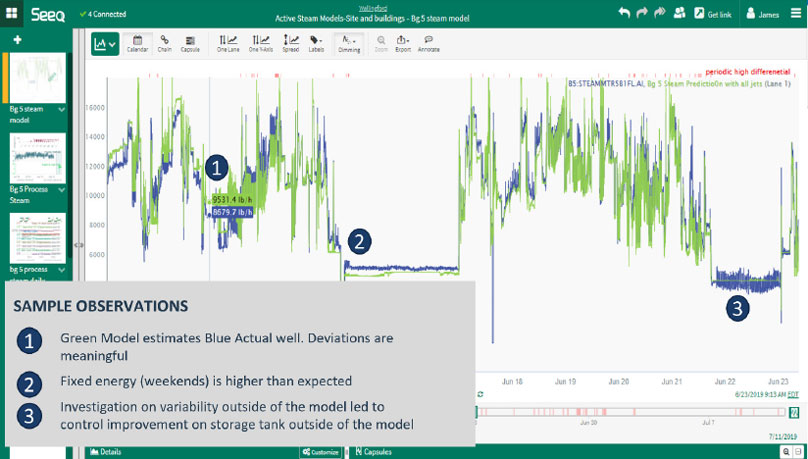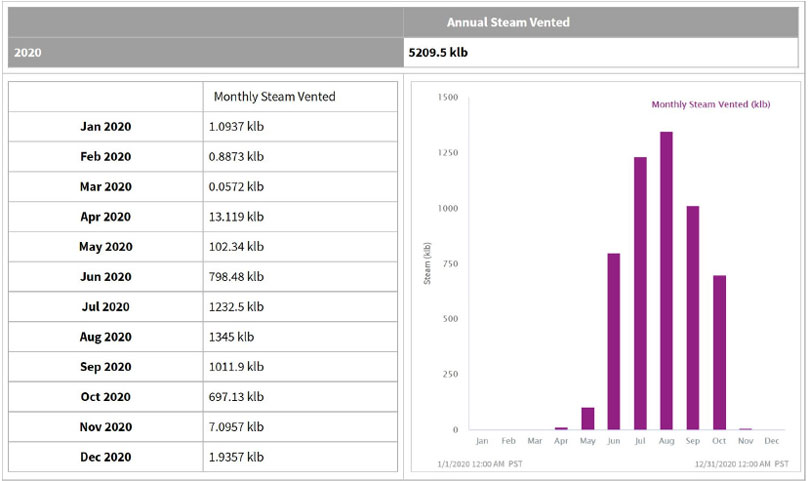- By Morgan Bowling
- May 01, 2023
- Smart Manufacturing (Industry 4.0)
Summary

Leverage models and algorithms to reduce costs, waste, and carbon emissions.
In the era of Industry 4.0 and manufacturing digital transformation, data is at the core of every successful sustainability initiative. While most process manufacturers have been collecting time-series process data for decades, these projects cannot progress without historical context, a frequently lacking component.
Most manufacturers are using data management platforms to store and secure this information, but preparing these process data streams for analysis often does not occur. This step must be completed with both historical data and current/future data aggregation. Only then can subject matter expert (SMEs) analyze this information to identify opportunities for operational optimization and help teams progress toward corporate sustainability initiatives.
While sustainability is recognized as an area of importance for almost all organizations, many are at a standstill because they lack the mechanisms to condition data for insightful analysis. They face obstacles accessing and connecting to their many disparate data sources, as well as cleansing and contextualizing the data. This prevents these companies from creating and operationalizing insights to increase operational efficiency and reduce emissions.
Fortunately, modern advanced analytics solutions are empowering process manufacturers to find, share, and act on insights derived from their seemingly endless data streams, helping operations and engineering teams drive sustainable practices.
Challenges with antiquated data tools
As both the accessibility and volume of data increase, the limitations of legacy software options are becoming clearer: They simply cannot be counted on to find and operationalize data-based insights.
While sustainability is recognized as an area of importance for almost all organizations, many are at a standstill because they lack the mechanisms to condition data for insightful analysis.
The first challenge is accessing data. Process manufacturers have a variety of existing data sources across multiple databases hosted on-premises or in the cloud, such as process historians and asset management systems. Traditionally, teams have used standard spreadsheet-based tools to collect, cleanse, and align time series data from these sources to the best of their abilities. However, these efforts are labor- and time-intensive for the process experts, engineers, and data scientists typically tasked with the work.
After spending a significant amount of time compiling data in a spreadsheet, SMEs must analyze it to identify opportunities for environmental improvement. However, organizations cannot improve what they cannot measure. Spreadsheets lack a seamless method for visualizing and validating process data, making spreadsheet-based analysis cumbersome and error-prone, in addition to time-consuming. This prevents the deep analysis required to increase efficiency in process environments.
Without the right solutions, most sustainability metrics are either not calculated, inadequately monitored, or recorded too late, preventing operations teams from taking timely and informed action. This causes the organization to act in a reactive manner because issues are only brought to light in reports that are often only prepared on a quarterly or annual basis. This prevents teams from proactively making operational changes to minimize or avoid emissions events.
Software solutions support sustainability
With the right self-service advanced analytics solution, SMEs can gain insight into historical and near-real-time process data, including access to environmental parameters. Using these types of tools, teams can immediately alleviate the challenges of live data connectivity, because the software automatically aggregates data from many types of disparate sources into a single platform. Automated data cleansing and contextualization enable engineers to significantly reduce the time spent preparing data for analysis and instead focus on process improvements like optimizing environmental performance.
Without data access and preparation barriers to worry about, SMEs can use purposebuilt, point-and-click tools for descriptive, diagnostic, predictive, and prescriptive analytics to improve environmental performance based on reliable insights. Advanced analytics solutions incorporate visualization into the analysis workflow, empowering SMEs to see the impact of their analyses in near real time, pinpoint missteps, identify successes, and iterate and innovate more quickly than before.
Data visualization capabilities also make it easier to communicate environmental performance metrics efficiently. For example, teams can shift from reactive to proactive approaches by continuously monitoring parameters to detect and mitigate emission limit breaches. This helps facilitate rapid reactions to events while providing root cause assistance to SMEs.
In addition, by using advanced analytics solutions to build models and predict process behavior, the impacts of operational changes on an organization’s environmental performance become apparent. For example, energy models based on steam generation and consumption in the plant can be referenced to change operations and reduce steam use, by extension reducing overall plant energy consumption (Figure 1).

The real-time collaboration capabilities facilitated by advanced analytics solutions help make sustainability a shared goal throughout an entire organization because insights and methods can be quickly communicated. This reduces information silos and alleviates calculation errors present when performing analysis using spreadsheets. Leveraging streamlined communication, knowledge capture, and reporting, these solutions enable organizations to maximize SMEs’ effectiveness regardless of the time zone or work location.
Justifying an idle boiler
To reduce carbon emissions and minimize environmental impact, process manufacturers must be able to identify time periods of wasteful operation and quantify the waste as financial loss or CO2 emissions equivalent. This allows companies to establish common benchmarks for comparing alternative operating strategies. These wasteful periods often occur in the form of vented steam or excessive electricity usage.
A major U.S. refiner executed a study using an advanced analytics solution to justify idling one of its boilers in a dual-boiler operation during the warmer months of the year. The company’s data scientists configured the solution to identify time periods when the dual boiler system was operating at minimum firing rates while venting steam. After examining these wasteful periods, the team easily determined potential annualized steam savings (Figure 2).

Reducing carbon emissions
A global chemical manufacturer pledged to cut its carbon intensity in half by 2030. The first step toward this ambitious goal was understanding the current state of operations, an analytics activity that was previously so cumbersome that the company only executed it once a year. However, carbon intensity calculations provide critical insights about overall carbon footprint and emissions that were necessary to efficiently progress toward the company’s sustainability goals.
By deploying advanced analytics, engineers gained real-time awareness of site utility stream carbon intensity. Within the solution, SMEs converted process sensor data into carbon mass equivalencies to enable comparison of current versus target carbon intensity for a given production quantity. Breaking up the carbon footprint into individual utilities enabled operations teams to understand the most significant contributors when operating in excess of the target, as well as the leverage to combat them.
These overall carbon intensity estimates empowered the chemical manufacturer to make data-driven decisions to target carbon reduction on an ongoing basis, making measurable progress toward its 2030 goal. Building a culture of carbon reduction driven by analytics also helped the company emerge as a chemical industry leader in sustainability.
Economic returns and competitive differentiation
There is no doubt that sustainability initiatives will continue to drive incremental and transformational change. The adoption of runtime measurement and validation facilitates movement toward increasingly proactive production systems, which help establish dynamic mitigation and preemptive detection of emission events.
The actions of individual companies have consequences beyond the fence of a plant, or boundaries of the enterprise. Sustainability initiatives impact everyone and also create opportunities for differentiation and competitive advantage, especially in industrial and manufacturing markets. With digital technologies and modern analytics solutions, runtime visibility is plausible and common, empowering organizations to confidently control inputs that drive desired results.
Many manufacturing companies are leveraging process data in their quest for operational excellence, and more are beginning to use it in sustainability initiatives as well. This trend will continue, because company bottom lines can no longer solely depend on high throughput and maximum profitability—environmental impact and recognition must also be considered.
Regardless of the industry, sustainabilityfocused projects need not require significant capital investment. Instead, organizations can make positive environmental adjustments by analyzing their data to create insights and make better use of existing assets. By applying self-service advanced analytics to operational data, organizations can continue to pursue ambitious carbon neutrality goals that will foster sustainable practices for generations to come.
All images courtesy of Seeq
Webinar: Accelerate Sustainability Outcomes
Top organizations are leveraging their existing data infrastructure to gain new visibility into their operations and reach their sustainability goals. optimize energy efficiency and minimize emissions. Morgan Bowling, industry principal at Seeq, and Anthony Teodorczuk, technical support and operations manager at SBM Offshore, discuss key sustainability initiatives and dive into use cases of best practices around emissions monitoring and reporting. In the webinar, the two discuss:
-
Key sustainability challenges focused on the availability and access to data
-
How organizations can accelerate their path to sustainable operations
-
Actionable steps to drive progress towards net zero emissions by optimizing energy efficiency, minimizing environmental impact, and streamlining regulatory reporting.
Reader Feedback
We want to hear from you! Please send us your comments and questions about this topic to InTechmagazine@isa.org.


